Have you ever watched a horror movie with no sound? It’s awful. It’s just a bunch of people looking dumb and falling down a lot. That’s what your car is like if it has a terrible exhaust system.
It doesn’t matter how nice the ride is, how powerful it is, or how good it looks; the first thing people notice when you roll into a meet is how it sounds. That means they’ll have made all the judgments they are going to make before you even come to a stop.
A good resonator is a great way to make sure your exhaust system commands respect instead of turning up noses.
- A Short Guide to Resonators
- Top 10 Best Exhaust Resonators 2026
- 1. Best Overall Exhaust Resonator: Vibrant Bottle Style Resonator
- 2. Best Premium Exhaust Resonator: Vibrant Ultra Quiet Resonator
- 3. Best Budget Exhaust Resonator: DC Sports EX Bolt-On
- 4. Best Inexpensive Inline Exhaust Resonator: LCGP Weld-In Resonator
- 5. Best Performance Exhaust Resonator: Borla Stainless Steel Resonator
- 6. Best Tip-Style Exhaust Resonator: Borla 20248
- 7. Best Clamp-On Exhaust Resonator: LCGP Clamp-On Resonator
- 8. Best Dual Exhaust Resonators: SLP Loud Mouth Pair
- 9. Best Factory Mount Exhaust Resonator: Walker 21398 Resonator
- 10. Best Resonator Alternative: Speedway Motors Combo Exhaust Pipe
- The Big Guide to Exhaust Resonators
- Enjoy That Sweet Music
A Short Guide to Resonators
Whether you are building a custom exhaust system or just replacing a rotted component, there are things you need to know before buying a new exhaust resonator. Giving you that information is what we aim to do. First, with this short guide, and then with a list of the best resonators on the market right now. Finally, we’ll hit you with a big guide that expands on some of the concepts we cover in the quick guide and some big picture ideas concerning exhaust system design.
Mufflers vs. Resonators
Many people tend to confuse resonators with mufflers, but they are actually separate components in an exhaust system. Adding to the confusion is the fact that different cars have one, the other, neither, or both. We’ll go more into exhaust systems in the big guide at the bottom, but here let’s talk about the two exhaust system pieces that effect sound the most.
Mufflers
Mufflers make your car quieter. They “muffle” the sound. Sometimes, mufflers have designs similar to resonators, but a muffler is primarily meant to lower your exhaust’s decibel level.
Resonators
Unlike mufflers, resonators are not meant to make your car quieter. Instead, they change the profile of the sound your car creates. They are often mounted before mufflers and can be called “pre-mufflers” because of that.
The most common reasons to install a resonator are to eliminate droning and rasping. Droning is constant, unpleasant noise at certain RPMs, while rasping is the harsh metallic sound you can get as the RPMs climb. Here’s a great example on YouTube, and we’ll hit on it more in our big guide at the bottom.
Making Sure It Fits Your Car
One of the biggest considerations when buying an exhaust resonator is whether it can be used with your vehicle or not. The answer comes down to 3 main properties.
Installation
We’ll hit this category again in the big guide, but there are a variety of ways that a resonator can be installed.
Most need to be welded in place, but some simply slip over the existing pipe and are clamped. Factory and factory replacement resonators, which are perhaps the easiest inline resonators to install, use standard flanged fittings that bolt directly to existing components.
Size
This is a bit obvious, but if you plan on installing a resonator that’s 3ft long and 8in in diameter, but are driving a tiny car, it’s not going to work.
Usually, if you are replacing a stock resonator with an aftermarket resonator, you’ll have no issue. Those of you with custom exhaust systems will have to get the tape measure out, though.
Inlet Diameter
Not all exhaust pipes are the same diameter. In fact, they vary wildly based on a lot of factors. You can adapt the size up or down, but that’s not an ideal way of doing things. It’s better to go out and measure your car’s exhaust at the point of installation instead.
Resonator Designs
Most resonators work in the same way. They create space for sound to resonate, and you can tune them to emphasize or eliminate different noises. The easiest way to understand how they work is to picture yourself shouting inside a metal shed versus shouting inside a concert hall. You’ll sound way better in the concert hall because of the extra space and low-frequency response.
Sound
Since they all work similarly, the biggest differences in resonator design concern sound. A resonator allows the sound to bounce around inside the space it creates and lowers the energy of the high-frequency waves. In other words, it’s making the bass come through better while killing the highs.
In our reviews, we will try and give you an idea of how each resonator will shape your sound, but the truth is that every car and every exhaust system is different. Searching YouTube or going to local car meets will give you a much better idea of how your vehicle will sound with varying styles.
Now that you’ve got the basics down, let’s jump into our list of best resonators. We tried to get a good selection that ranges from ultra-easy to install to ones that require professional installation, so you are bound to find something that fits your needs.
Top 10 Best Exhaust Resonators 2026
1. Best Overall Exhaust Resonator: Vibrant Bottle Style Resonator
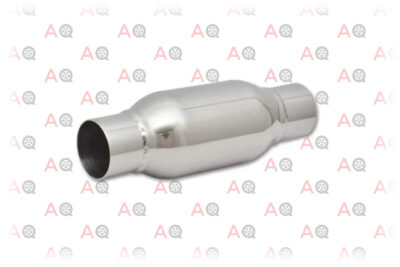
Editor’s Rating:
Will It Fit?
With a very modest 12″ length and a very common 2.5″ inlet diameter, it’s improbable that this resonator will not fit your system.
However, like with all weld-in designs, it’s a bit harder to install than others. It needs to be installed between the catalytic converter and the muffler, and that means you will need to hack apart your current system to place it in. That’s pretty common, so it’s not bad, but it is much easier to install units like the DC Sport tip or the slip-on LCGP resonator.
How Does It Sound?
A small resonator like this is really good at cleaning up your exhaust sound without altering the tone. Basically, you’ll get a lot less drone and rasp. If you like the sound of your car already and just want to clean up the sound, it’s perfect.
The only thing that might leave you wanting is that it doesn’t improve the bass response. In fact, if you have a quiet exhaust already, you may not even notice a difference.
Our Take
There are two resonators on our list that are very, very similar apart from one thing. This one, the Vibrant Bottle, is a lot less expensive than the very similar Vibrant Ultra Quiet Resonator.
They are both about the same size, and they both do the same thing: they kill the rasp and the drone. Simply put, the Vibrant Bottle is just the inexpensive, slightly lower quality version of the Ultra Quiet. It’s not bad by any means, but the finish isn’t as nice, and it doesn’t flow quite as well. You can see it instantly by looking at the pictures. The Bottle resonator just doesn’t look as good. For the ratio of price, quality, and sound, though? We have to say the Vibrant Bottle is the best in class.
Pros
- It’s a really good value
- It kills the drone and the rasp
- It’s a good size for most cars
Cons
- You won’t notice much of a difference if you have a quiet car
- Not particularly easy to install

Editor’s Rating:
Will It Fit?
This particular model has a 3″ inlet and outlet, though they sell the most common diameters. It is only a little bigger than the Vibrant Bottle, and that means chances are it will fit whatever vehicle you plan on attaching it to.
Like the Vibrant Bottle, it’s best suited for welding inline between the catalytic converter and the muffler.
How Does It Sound?
The Ultra Quiet absolutely excels at cleaning up your exhaust sound. Do you have a harsh rasp, droning, or rattly tin-like sound? All of that will be gone with the Ultra-Quiet. Like the Vibrant Bottle, it doesn’t really change the tone too much. It just turns your car from an old 8-track format to a modern high-bitrate MP3.
Unlike most resonators, though, the Vibrant Ultra Quiet will make your exhaust a bit quieter. Up to 15db quieter, which is often just enough to make your car legal in California. That can be a great thing if you want to be a little stealthier without sacrificing tonality. At the same time, it can be terrible if you believe that loud pipes save lives.
Our Take
One more thing we want to point out is that this resonator is really pretty. The rolled edges, the machine welded inlets, and the polished stainless steel all make for a great looking piece of exhaust gear. It’s a shame you’ll be sticking it under your car, where no one can see it.
All in all, the Vibrant Ultra Quiet is just a really great resonator. It is more costly than most others, which is unfortunate. Still, the quality and performance are also higher than others, so it works out.
Pros
- It’s good looking
- It works great for cleaning up the exhaust sound
- It will quiet down your car
Cons
- It will quiet down your car
- It’s expensive
3. Best Budget Exhaust Resonator: DC Sports EX Bolt-On
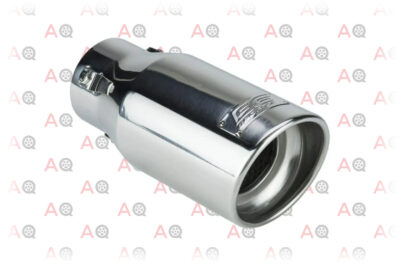
Editor’s Rating:
Will It Fit?
The DC Sports resonator uses 3 tabs to clamp onto anything it fits over. This one will work on pipes ranging from 1.75″ all the way to 2.5″, though they sell bigger ones. Plus, since they just bolt to the end of the pipe, you usually don’t have to modify your vehicle. There isn’t anything easier to install or more universal on our list.
How Does It Sound?
Like the other more expensive exhaust tip on our list, the Borla tip resonator, the DC Sports Bolt-On adds bass. It won’t totally kill rasp or drone, and it won’t do anything for volume, but it will make your engine sound like it makes a little more power by upping the bass.
What you really need to keep in mind when you look at the DC Sports Bolt-On is that it costs $20 and is meant to fit anything. Don’t expect miracles. It won’t make your stock Civic DX sound like a new Type R. It will, however, make your Civic sound a little faster when you floor it onto the freeway.
You can hear one in action in this YouTube video and see if it fits the bill.
Our Take
It’s $20, and it will make your car sound a little bit better. It’s tough to criticize something that costs so little and is so easy to install. As long as you don’t go in expecting it to perform the same as the Vibrant Ultra Quiet or anything, there’s no reason you won’t be happy.
You’ll just have to get over two hurdles. It’s not a significant sound upgrade, and some people might not like how it changes the tone. Yes, it adds some bass, but on some vehicles, that’s not a desirable thing.
The other thing you’ll have to do is ignore the haters. These types of resonators have a harsh reputation among car enthusiasts, and you’ll absolutely hear terms like “Rice” and “AutoZone Junk.” It’s your car, though, and a car is a platform for you to express yourself. Tell the haters to go pound sand.
Pros
- It’s inexpensive
- It’ll fit everything from a motorcycle to a big SUV
- It can be installed with simple hand tools
Cons
- It doesn’t sound as good as an inline resonator will
- Clamp-on exhaust tips have a bad reputation
4. Best Inexpensive Inline Exhaust Resonator: LCGP Weld-In Resonator

Editor’s Rating:
Will It Fit?
The LCGP resonator is both a glass pack muffler and a resonator, so chances are it will fit any custom system. The problem is that you can’t just drop it into a system. It’s weld-in only, and unlike a component that’s only a resonator, you run the risk of really altering your engine’s sound for the worse. That means you do need to do a little research and planning before committing to this product.
The good news is that you can use it for a single component exhaust since it’s a muffler and a resonator.
How Does It Sound?
Like the other resonator on our list that lowers the volume, the Vibrant Ultra-Quiet, the thing you will notice most is that the LCGP kills rasp and makes the car a little quieter. It’s not as good at getting rid of a loud drone, though.
Where it shines is if you use it as a single component. When you do, you are going to get that very traditional glass-pack sound. You’ll get rid of pops and annoying high-frequencies that you would otherwise get with a straight pipe, but you won’t get rid of the growl.
Our Take
Cheap exhausts are a staple of entry-level car builds. It’s really easy to see why; a good exhaust system can easily cost two thousand dollars or more. The problem is that cheap parts usually have low quality, and they don’t sound good. The common term for these systems is “Fart Cans,” which is not meant endearingly.
Building the system piece by piece is a good way to avoid many pitfalls that a cheap eBay system brings. The LCGP is inexpensive, but still has a good sound and an ok build quality. You lose convenience since universal parts are harder to install.
You make up for that loss by getting a resonator that can pass for a quality exhaust component. They even make one that clamps on instead of welds in; it’s on our list here.
Just know that whether you are clamping or welding, it’s not a premium product. The insides will break down faster than other units, and you will be replacing them sooner. As we mentioned above, it’s a perfect entry-level part.
Pros
- It’s inexpensive
- It can be used instead of a muffler if you want
- It sounds better than the price would suggest
Cons
- It won’t last as long as dedicated components will
- It’s harder to install
5. Best Performance Exhaust Resonator: Borla Stainless Steel Resonator
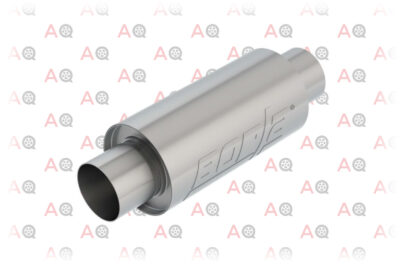
Editor’s Rating:
Will It Fit?
The Borla Resonator is universal, so just like the Vibrant Bottle or Ultra Quiet, if you have the same exhaust diameter as the part, it will fit.
Although this is Borla we are talking about, they don’t make installation simple. It’s short, precise, and absolutely needs to be welded in. With other cheap resonators you might get away with using a steel exhaust clamp and JB weld, but you are getting rid of everything that makes the Borla nice if you do that with this resonator.
How Does It Sound?
It sounds beautiful. Borla is one of the masters of exhaust tuning and noise, so they make parts that make your car sound more powerful. Their resonators tune out sharp pops and high-frequencies to give you a really smooth, nice growl. This video does a good job of showcasing what they sound like.
Our Take
The truth is that you probably aren’t going to be happy if you buy an expensive performance resonator like this and aren’t putting it in an expensive, performance exhaust system. If you are doing a simple upgrade to a car, the Vibrant Bottle or LCGP Universal resonators are absolutely acceptable.
Everyone that is looking for maximum power and sound response, though, should look at the Borla resonator. If nothing else, people will see the Borla on the side of the can and nod knowingly. That is always fun.
Pros
- Borla has a great reputation for building good parts
- It sounds great
- It’s very free-flowing, for good performance
Cons
- It’s expensive
- You need a good exhaust system already to really take advantage of it
6. Best Tip-Style Exhaust Resonator: Borla 20248

Editor’s Rating:
Will It Fit?
Just like the DC Sports exhaust tip, the Borla resonating tip mounts to the end of your exhaust system and is super easy to install.
The difference is that the Borla is not a clamp-on. You must weld it in place, which means you also must get one with the same inlet diameter as your exhaust. It’s much easier to install than an inline weld-in component. However, you will still need to be comfortable welding stainless steel.
How Does It Sound?
Borla components always sound good. Their inline resonator is on our list too, and the reason both are on our list is because of how good they sound. The DC Sports exhaust tip gives a little bit of bass and takes away the raspiness. The Borla tip does the same thing, but better.
Our Take
The Borla exhaust tips have the same exact problem that the Borla inline resonator has. If you don’t have a nice exhaust system already, you won’t be getting the most from this product. You will be just as happy with the much cheaper DC Sports exhaust tip if you have a cheap system. There isn’t a massive difference in sound.
The looks and sound of the Borla tips can finish off a good system, though. If you are already in deep with modifications, they can be a great finishing touch.
Pros
- It looks good
- It sounds good
- It’s easy to fit onto any system
Cons
- You need a good exhaust to take advantage of it
- It’s more expensive than most exhaust tips
7. Best Clamp-On Exhaust Resonator: LCGP Clamp-On Resonator
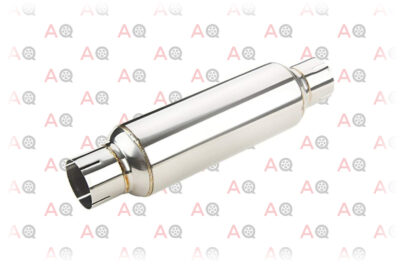
Editor’s Rating:
Will It Fit?
There’s no reason it won’t fit any system. The fact that it clamps in instead of welds actually makes it the easiest inline component to install on our list. Clamps can leak over time, which is their biggest weakness, but if you don’t have a welder, then you don’t have much of an option.
Keep in mind that unlike weld-in resonators, when you cut out a section to install it you have to leave enough leftover to clamp onto. You’ll also need the space to slip it on, which can be annoying if you don’t drop the system.
How Does It Sound?
It sounds and acts just like the other LCGP resonator we have on our list; it just clamps on instead of welds on. The short of it is that it will reduce buzz, rasp, and drone, but it won’t lower the volume very much. You will get a slightly deeper tone, which can really improve the average factory system’s sound.
If you run it with a restrictive muffler, you might be disappointed with the performance. It is sound deadening in addition to a resonator, and with a restrictive muffler, you will lose a lot of bass tones.
Our Take
The big takeaway is that you can just clamp this in. Except for the bolt-on exhaust tip on our list, this is the easiest to install resonator for modified systems. You have to cut a section of your existing system out, but that’s the only step.
Like other inexpensive components, the quality is not going to be amazing. It does sound good for the price, and if you don’t know how to weld, you can still eliminate the drone and rasp from your ride. That alone makes it worth it for most.
Pros
- It’s an inline resonator that you don’t have to weld on
- It sounds good for the price
- Inexpensive
Cons
- Quality could be better
- The clamps can leak as they loosen over time
8. Best Dual Exhaust Resonators: SLP Loud Mouth Pair
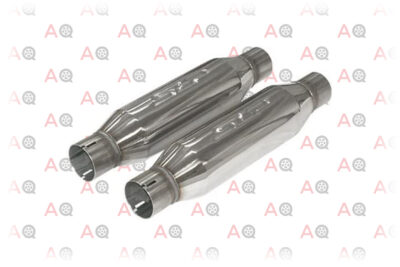
Editor’s Rating:
Will It Fit?
They sell the Loud Mouth Bullets as a pair, making them perfect for people who have a true dual exhaust system. To be fair, there’s no reason that you can’t simply buy two of any other resonators, but the fact that they come as a pair really makes them a convenient thing to order.
You can tell that even though they are universal, they are clearly made for muscle cars and trucks. Their sizes range from 2.5” to 4”, with no small diameters to be found, and all of their advertisements feature Mustangs and Chargers.
How Does It Sound?
Loud and angry. With resonators like the Vibrant Ultra-Quiet, you get both a nice reduction in drone, and you reduce the decibel level a bit. The Loud Mouth, like the name implies, does not reduce the decibel level at all. It increases it.
The place you’ll notice it most is at wide-open throttle. They sound like any resonator at low RPMs, with more pronounced bass and a reduction in raspiness. When you get your foot in it, though, they come totally alive, and all bets are off.
Our Take
SLP makes high-quality products, and they are well known for making performance car parts. These bullet style resonators are no different. They are high quality, sound amazing, and will absolutely let everyone in your neighborhood know that you are pulling out of your driveway.
They are expensive, especially if you buy them individually. They are averagely priced for the quality, though, and come in cheaper than the Borla resonators they compete against. In our opinion, if you have a 4-cylinder or inline 6, get the Borla. V6 and V8 people should get the Loud Mouths.
Pros
- They are loud
- They are high-quality
- They come as a pair
Cons
- They are expensive
- You will annoy your neighbors
9. Best Factory Mount Exhaust Resonator: Walker 21398 Resonator

Editor’s Rating:
Will It Fit?
Walker makes resonators that are meant to replace factory resonators. That means that their resonators just bolt right in. They are flanged, they are the same size as factory components, and they are the right diameter for your car.
The hard part is making sure you get the right one for your car. The easiest way is to just use Walker’s own website. The one included here is for a large variety of GM vehicles, which are well known for surviving for years and years with rotted exhaust components as they travel the US North’s salted roads.
How Does It Sound?
It sounds like a stock exhaust system. If you remember how your exhaust sounded before you had to replace the resonator, that’s how it will sound.
Factory resonators are usually built to cancel as much sound as possible to improve driver comfort, which makes them terrible for modified cars. If you already are replacing the resonator, and want a better sounding exhaust, consider getting an aftermarket resonator like Vibrant Bottle. It can really improve the tone over stock.
Our Take
Walker components are easy to install, cheaper than ordering a replacement from the factory, and they work just fine. We just wish they’d make them out of stainless steel so they’d last longer. If your old system rotted out due to rust, nothing is stopping the Walker from rotting out too.
Pros
- It’s inexpensive
- It’s super easy to install
- You don’t have to worry about fitment since they are designed for your vehicle
Cons
- The material it’s made from could be better
- It’s not universal
10. Best Resonator Alternative: Speedway Motors Combo Exhaust Pipe
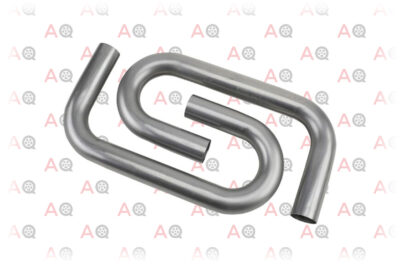
Editor’s Rating:
Will It Fit?
This solution is the most labor-intensive solution, and it requires the most fabrication skill. If you have the skills, then you can make a simple resonator for any vehicle.
Here’s how you do it:
- Figure out what RPM range causes the worst drone
- Figure out how many pulses per revolution your car makes (for 4 and 8 cylinder cars, it’s 4. A v6 might be 3 or 6. Don’t worry, there’s a lot of room for tuning after the fact)
- Plug those into this equation: 343/(RPM * Pulses * 1/60)
- Divide the answer by 4, and you’ll get ¼ of the wave. Hence the name “Quarter-Wave Resonator.”
- Cut a length of pipe of that length, in meters, and weld a cap on one end. Weld the other end into your exhaust pipe. The length can be straight, bent, or really any shape. The J-pipe, a length of pipe shaped like a J, is a really common shape because of how easily it can be made to fit in any situation.
This PDF lays out the details, but most importantly it has some really helpful pictures on page 15.
How Does It Sound?
The only thing this resonator style does is cancel out noise at the specific frequency you build it for.
This is pretty much the only way to truly fine-tune an exhaust sound. If you love the sound of your car except for some unwanted noise at 2k RPM, this is the right solution.
Our Take
No one should be afraid of math or engineering. Doing a very simple and cheap upgrade like a capped J-pipe can be an enjoyable way to put some of those classes you were forced to take to work.
It’s definitely not for everyone, though, and that’s why we included it last on our list. It is roughly 100 times easier to just buy a pre-built resonator like the LCGP Clamp-On and just slip it in place and clamp it on. And honestly, that will sound just fine. If you really enjoy fabricating custom parts for your car, though, this project can be a really fascinating dive into exhaust sound theory.
Pros
- It’s infinitely customizable
- It can be very, very cheap
- You can make it look however you want
Cons
- It’s not a project for someone with no tools
- It’s also not a project for someone that isn’t comfortable doing some hard research
The Big Guide to Exhaust Resonators
To really understand exhaust resonators, you need to know about the rest of an exhaust system. We touched on it a little bit up above, but here we’ll work from the heads to the tips.
The Exhaust System
An exhaust system’s main purpose is to take the hot gasses from the engine and get them out away from the car. Carbon-monoxide poisoning is no joke. Now, it is simple enough to do that with nothing but a length of pipe. That’s actually what “straight pipes” are, just lengths of metal pipe that go from the motor to somewhere away from the car.
Most people don’t appreciate ear-drum bursting noise, though, and the earth doesn’t appreciate unfiltered gasses being dumped into the atmosphere. That’s why most exhaust systems have other components.
Parts of an Exhaust System
The first component of the exhaust system is actually inside the engine. Once there is an explosion inside the cylinder, the piston pushes out the exhaust through an exhaust valve. That’s the part you don’t touch usually. The following are the components that most people will change during an upgrade. In order starting from the bumper:
- The Manifold or Headers: A manifold, or headers, collect the exhaust from the individual cylinders and combine them into one outlet.
- Y-Pipe: Cars with multiple manifolds/headers, but a single exhaust dump, will have a y-pipe that brings the two manifolds and combines them.
- Sensors: There are often “downstream” sensors before the catalytic converter and “upstream” sensors after. Some cars only have one; some have four.
- Catalytic Converter: A catalytic converter, often abbreviated as a “cat,” is a device that cleans the exhaust. It’s a neat process; you can read about it here. There are many aftermarket exhaust systems referred to as “cat-back” exhausts. That just means the part starts at the catalytic converter and replaces everything going back.
- Resonators: Resonators change the tone by eliminating certain frequencies.
- Mufflers: A muffler alters the sound of your exhaust the most. A good muffler will lower the volume without being restrictive, but most factory mufflers will sacrifice performance for noise reduction.
- Exhaust Tip: Often, the system ends at the muffler, and the muffler will have its own tip. However, some cars have the muffler located further away from the exit or have mufflers with interchangeable tips. The tip is just the end of the pipe.
Do I Really Need a Resonator?
If you spend time at car shows or race events, you’ll notice many cars out there that don’t have specific exhaust components. Most dedicated track cars will just run straight pipes or open headers. Picture the cars in Mad Max. Most of those have an open header design where the entire exhaust system is just a few short pipes that stick out of the hood.
That might lead you to wonder if you really need a resonator at all, and the answer is that you don’t. Unlike catalytic converters, which are required in most states, or mufflers required to avoid noise violations, a resonator is not strictly necessary.
The Benefits of a Resonator
Open pipes are loud, make annoying sounds, and can drive you insane when they “drone” while you drive down the road. Adding a muffler is good, but often a muffler alone won’t get rid of raspiness or annoying drone. That’s where a resonator comes in.
You can also use a resonator to tune in a sound you like. The Borla resonators, for instance, will give your exhaust note more bass. The bass growl is associated with power, and making your car sound powerful is good.
It really helps to hear it for yourself, though, so here is a video of the Vibrant Ultra Quiet Resonator in action. We really like this example because it includes in-car audio, and it includes a before and an after. You can compare them directly and really hear how much of the high-frequency buzzing is eliminated after the install.
Speaking of installing them, let’s talk about mounting them to your system.
Welding, Flanges, and Clamping

We talk a lot about how different resonators install, so we will get in-depth on this section’s different options.
Flanged Fittings
Flanged fittings are the way factory and complete systems are held together. Most flanges either have two or three bolts and are usually gasketed. When you buy a cat-back exhaust that is meant to bolt to the factory catalytic converter, chances are it will be this style. Likewise, if you buy a factory replacement part, like the Walker on our list, it’ll bolt-on in this style.
Clamp-On
Technically all exhaust components can be clamped using various specialized no-weld clamps, but there are components like the LCGP clamp-on resonator we recommend that are specifically built to be clamped in place. They have cuts and flairs that allow them to easily slip over existing piping and be clamped down.
Like the DC Sport exhaust tip, others are just oversized and include bolts that lock the part onto a pipe. You can’t use the bolt style clamps on inline resonators since they leave large gaps between the bolts. It doesn’t matter if exhaust leaks out around the tip; it’s already away from the vehicle.
Weld-In
Here’s the truth about weld-in components. You don’t have to weld them in; there are many different ways to attach them. There are flush clamps, tapes, no weld glues, and all sorts of custom solutions. A shop may choose to flair the pipe so that the component easily slides into place for easier clamping or welding.
The reason they are called weld-in components is that that is what they are designed for. They are the same size as the pipe that they will be installed on, making it easy to line them up and weld.
Welding vs. Clamping
Since weld-in components can be welded or clamped on, you have to choose between the two methods. Although the biggest consideration is whether or not you have access to a welder, there are pros and cons.
Pros of Welding Instead of Clamping
- Stronger
- Less likely to leak
- Allows a greater level of customization
- Looks better
Pros of Clamping Instead of Welding
- Much easier to install
- Can be taken apart later without cutting
- Can attach components that are a different material than the pipe
Premium exhaust systems will usually employ both methods. They will have a few places that clamp together to make installing the system easier since long, heavy pipes can be hard to work with. However, most components will be welded in place to improve durability and reduce the chance of leaking.
Enjoy That Sweet Music
A good exhaust note is what separates the cars that turn heads from the cars that get tickets. It’s such an important part of completing an automotive build, and it’s something a lot of people aren’t willing to take the time to learn about. Don’t be that person; we made this guide to make it easy to tune in the perfect sound for your vehicle. Grab or fab a resonator and enjoy being able to talk to your passenger as you cruise down the road.


